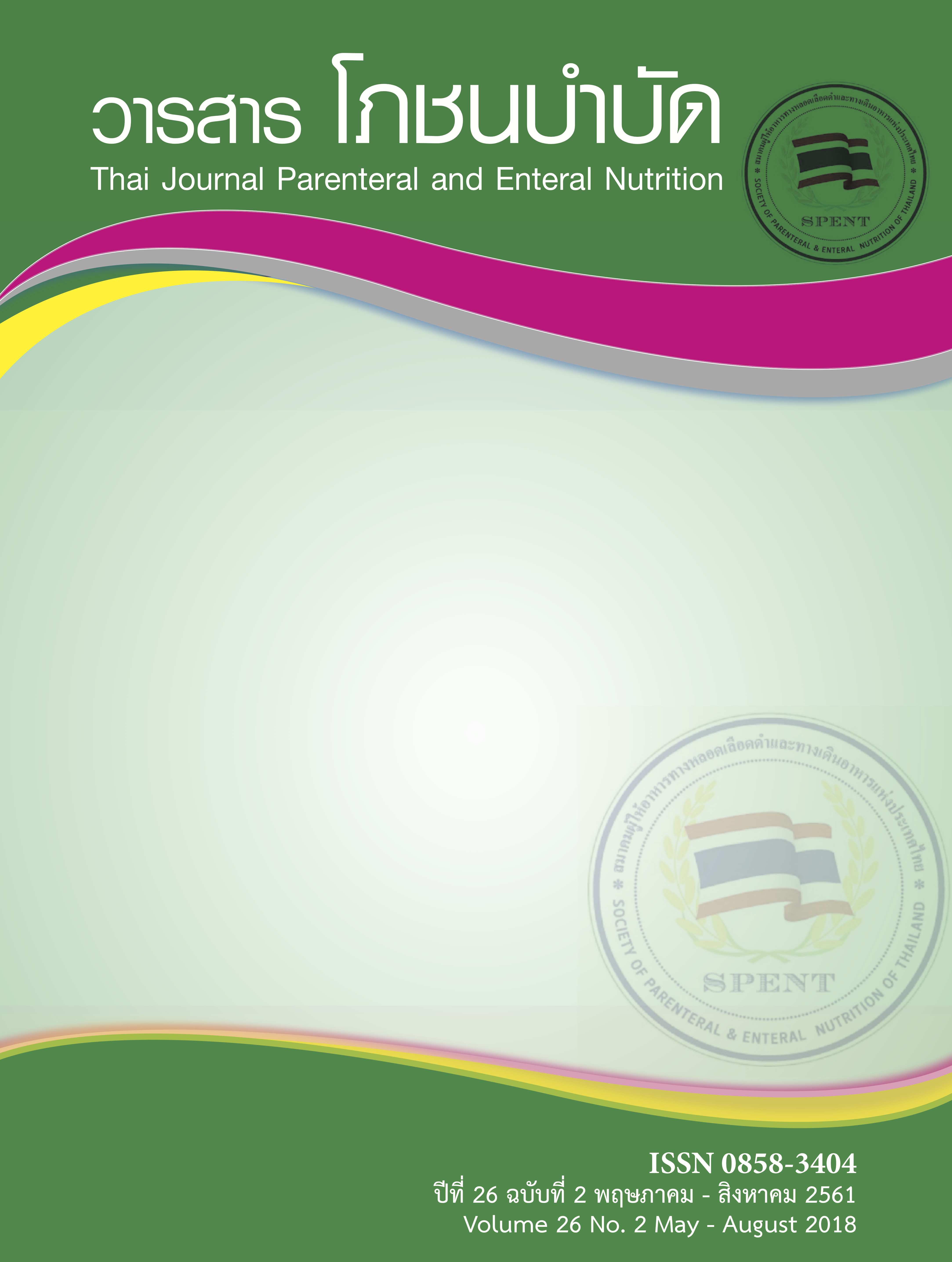พืชผักสมุนไพรเพิ่มรสชาติ คุณค่าทางโภชนาการ และฤทธิ์ต้านอนุมูลอิสระของอาหารพื้นบ้าน
คำสำคัญ:
พืชสมุนไพร, เพิ่มรสชาติ, คุณค่าทางโภชนาการ, ฤทธิ์ต้านอนุมูลอิสระ, อาหารพื้นบ้านภาคเหนือบทคัดย่อ
พืชผักสมุนไพรเป็นส่วนประกอบสำคัญของอาหารพื้นบ้านไทยและทั่วโลก ทำให้อาหารมีรสชาติกลมกล่อม เพิ่มสีสันกลิ่นหอมตามธรรมชาติ และคุณค่าทางโภชนาการสูง พืชสมุนไพรหลายชนิดมีบทบาทในการป้องกันโรคเรื้อรัง ชะลอความเสื่อมของร่างกายและบำบัดโรค การศึกษาในปัจจุบันพบว่าพืชสมุนไพรมีฤทธิ์ต้านอนุมูลอิสระ หรือยับยั้งกระบวนการออกซิเดชันที่ทำให้เกิดสารอนุมูลอิสระ สารต้านอนุมูลอิสระได้แก่ วิตามินซี วิตามินอี แคโรทีนอยด์ และสารประกอบฟีนอลิก มีฤทธิ์ต้านการอักเสบ ต้านมะเร็ง ป้องกันการเกิดโรคไม่ติดต่อเรื้อรัง เช่น โรคเบาหวาน โรคหัวใจและหลอดเลือด แต่คำถามที่สำคัญคือควรบริโภคพืชสมุนไพรอย่างไรจึงจะเกิดประโยชน์ต่อสุขภาพ บทความนี้มีจุดประสงค์เพื่อทบทวนการศึกษาเกี่ยวกับพืชผักสมุนไพรซึ่งสามารถเพิ่มรสชาติในอาหารพื้นฐาน คุณค่าทางโภชนาการ ฤทธิ์ต้านอนุมูลอิสระ และข้อแนะนำในการบริโภคเพื่อให้เกิดประโยชน์ต่อสุขภาพ
เอกสารอ้างอิง
Ministry of Public Health Department for development of Thai traditional and alternative Medicine. Academic textbook. Food for health. Bangkok: The
War Veterans Organization of Thailand Publishing Office; 2008 (in Thai).
The Royal Institute. The Royal Institute Dictionary 1982. 5, editor. Bangkok: Aksorn Charoenthat Company Limited; 2002 (in Thai).
Anantathanachai R, Kittiwatapol T, Kulsetticheee C, Onwimon N, khansee A, Jaruchipan K, et al. Development of Healthy Thai Food Set Menus based on
the Sufficiency Economy Philosophy and Community Context. SDU Res J 2010 3(1):59-74 (in Thai).
Chanwikrai Y, Suttajit M. Umami substances: Research history, mechanisms of delicious food taste and natural sources. Naresuan Phayao J. 2017;10(2):54-
(in Thai).
Tapsell LC, Hemphill I, Cobiac L, Patch CS, Sullivan DR, Fenech M, et al. Health benefits of herbs and spices: the past, the present, the future. The Medical
journal of Australia. 2006;185(4 Suppl):S4-24.
Perez-Jimenez J, Fezeu L, Touvier M, Arnault N, Manach C, Hercberg S, et al. Dietary intake of 337 polyphenols in French adults. The American journal of clinical nutrition. 2011;93(6):1220-8.
Carlsen MH, Blomhoff R, Andersen LF. Intakes of culinary herbs and spices from a food frequency questionnaire evaluated against 28-days estimated records.
Nutrition journal. 2011;10:50.
Szúcs V, Szabó E, Lakner Z, Székács A. National seasoning practices and factors affecting the herb and spice consumption habits in Europe. Food Control.
;83:147-56.
Mitchell M, Brunton NP, Wilkinson MG. The influence of salt taste threshold on acceptability and purchase intent of reformulated reduced sodium vegetable
soups. Food Quality and Preference. 2013; 28(1):356-60.
Chamchan R, Charoenkiatkul S, Thiyajai P, Suwanwattana W, Suttisansanee U, Srichamnong W, et al. Development of reduced sodium Geang-Pa-Kra-Chai-Pran. Plant Genetic Conservation Project under the Royal Intiative of Her Royal Htighness Princess Maha Chakri Sirindhorn (RSPG) Conference 8th; Saraburi, Thailand 2017.
Tantipopipat S, Jr., Boonpraderm A, Charoenkiatkul S, Wasantwisut E, Winichagoon P. Dietary intake of spices and herbs in habitual northeast thai diets.
Malaysian journal of nutrition. 2010;16(1):137-48.
Chanwikrai Y, Panturat N, Thussanasuwan N, Suttajit M. Development of Northern Thai food with soybean product for the healthy elderly person. Thai Dietetic
Association Conference çThe Challenge of Nutrition and Dietetics in Aging Societyé 2017; Bangkok 2017.
Pellegrini N, Salvatore S, Valtuena S, Bedogni G, Porrini M, Pala V, et al. Development and validation of a food frequency questionnaire for the assessment of dietary total antioxidant capacity. The Journal of nutrition. 2007;137(1):93-8.
Tangkanakul P, Trakoontivakorn G, Auttaviboonkul P, Niyomvit B, Wongkrajang K. Antioxidant activity
of Northern and Northeastern Thai foods containing indigenous vegetables. Kasetsart J(Nat Sci). 2006; 40:47-58.
Chompoonich S, Sidthibud Y, Boonrat C, Charoenwiriyawong J. Nutrition value and medicinal properties of indiginous vegetable and herb. Bangkok:
Quick Print Offset; 2006 (in Thai).
Wongsrisom N, Jinata J, Manosan B, Kuntakhoo J, Wankuan S, Sriyam S. Anti-Bacterial Activities of Essential Oils from Mah-Khwuaen (Zanthoxylum limonella Alston). KMUTT Research and Development Journal. 2014;37(1):3-15.
Thai plant data [Internet]. 1996 [cited August 18, 2018]. Available from: http://www.rspg.or.th/plants_data/index.htm.
Opara IE, Chohan M. Culinary Herbs and Spices: Their Bioactive Properties, the Contribution of Polyphenols and the Challenges in Deducing Their True Health
Benefits. International Journal of Molecular Sciences. 2014;15(10).
Boonla P. Antioxidant and antimutagenic activities of Piper sarmentosum Roxb. Leaf extracts. Isan Journal of Pharmaceutical Sciences. 2014;10(3):283-.
Suttajit M, Banjerdpongchai R, Kukongviriyapan V, Siriamornpun S, Chaiyasut C, Porasuphatana S, et al. Free radicals andantioxidants. Chiang Mai: Smart
Coating and Services; 2012.
Ames BN, Shigenaga MK, Hagen TM. Oxidants, antioxidants, and the degenerative diseases of aging. Proceedings of the National Academy of Sciences of
the United States of America. 1993;90(17):7915-22.
Scalbert A, Williamson G. Dietary intake and bioavailability of polyphenols. The Journal of nutrition. 2000;130(8S Suppl):2073s-85s.
Maneetong S. Extraction and antioxidant activity in four types of medicine plant by using DPPH radical scavenging assay. 2016 (in Thai).
Dangubon P. Flavonoid Content and Free Radical Scavenging Activity of Herbs Commonly Used in Thai Dishes. Bangkok: Faculty of Medicine Ramathibodi
Hospital, Mahidol University; 2007.
Turkmen N, Sari F, Velioglu YS. The effect of cooking methods on total phenolics and antioxidant activity of selected green vegetables. Food Chemistry.
;93(4):713-8.
Xu G, Ye X, Chen J, Liu D. Effect of heat treatment on the phenolic compounds and antioxidant capacity of citrus peel extract. Journal of agricultural and
food chemistry. 2007;55(2):330-5.
Somdee T, Pichainarong N, Yangyeun S, Mahaweerawath U, Wibuloutai J. Antioxidant activity of herbal vegetables in Tom Yum Goong, before and after heat treatment. Journal of science and technology Mahasarakham University. 2014 (in Thai); 33(5):428-36.
Racchi M, Daglia M, Lanni C, Papetti A, Govoni S, Gazzani G. Antiradical activity of water soluble components in common diet vegetables. Journal of agricultural
and food chemistry. 2002;50(5):1272-7.
Zhang D, Hamauzu Y. Phenolics, ascorbic acid, carotenoids and antioxidant activity of broccoli and their changes during conventional and microwave cooking.
Food Chemistry. 2004;88(4):503-9.
Choi Y, Lee SM, Chun J, Lee HB, Lee J. Influence of heat treatment on the antioxidant activities and polyphenolic compounds of Shiitake (Lentinus edodes)
mushroom. Food Chemistry. 2006;99(2):381-7.
Kim S-Y, Jeong S-M, Park W-P, Nam KC, Ahn DU, Lee S-C. Effect of heating conditions of grape seeds on the antioxidant activity of grape seed extracts.
Food Chemistry. 2006;97(3):472-9.
Ng ZX, Chai JW, Kuppusamy UR. Customized cooking method improves total antioxidant activity in selected vegetables. International journal of food sciences
and nutrition. 2011;62(2):158-63.
Morales FJ, Jiménez-Pérez S. Free radical scavenging capacity of Maillard reaction products as related to colour and fluorescence. Food Chemistry.
;72(1):119-25.
ดาวน์โหลด
เผยแพร่แล้ว
รูปแบบการอ้างอิง
ฉบับ
ประเภทบทความ
สัญญาอนุญาต
เนื้อหาและข้อมูลในบทความที่ตีพิมพ์ลงใน Thai JPEN วารสารโภชนบำบัด ถือเป็นข้อคิดเห็นและความรับผิดชอบของผู้เขียนบทความโดยตรงซึ่งกองบรรณาธิการวารสารไม่จำเป็นต้องเห็นด้วยหรือร่วมรับผิดชอบใด ๆ
บทความ ข้อมูล เนื้อหา รูปภาพ ฯลฯ ที่ได้รับการตีพิมพ์ใน Thai JPEN วารสารโภชนบำบัด ถือเป็นลิขสิทธิ์ของ Thai JPEN วารสารโภชนบำบัด หากบุคคลหรืหน่วยงานใดต้องการนำทั้งหมดหรือส่วนใดส่วนหนึ่งไปเผยแพร่หรือเพื่อกระทำการใด จะต้องได้รับอนุญาตเป็นลายลักษณ์อักษรจาก Thai JPEN วารสารโภชนบำบัด ก่อนเท่านั้น



